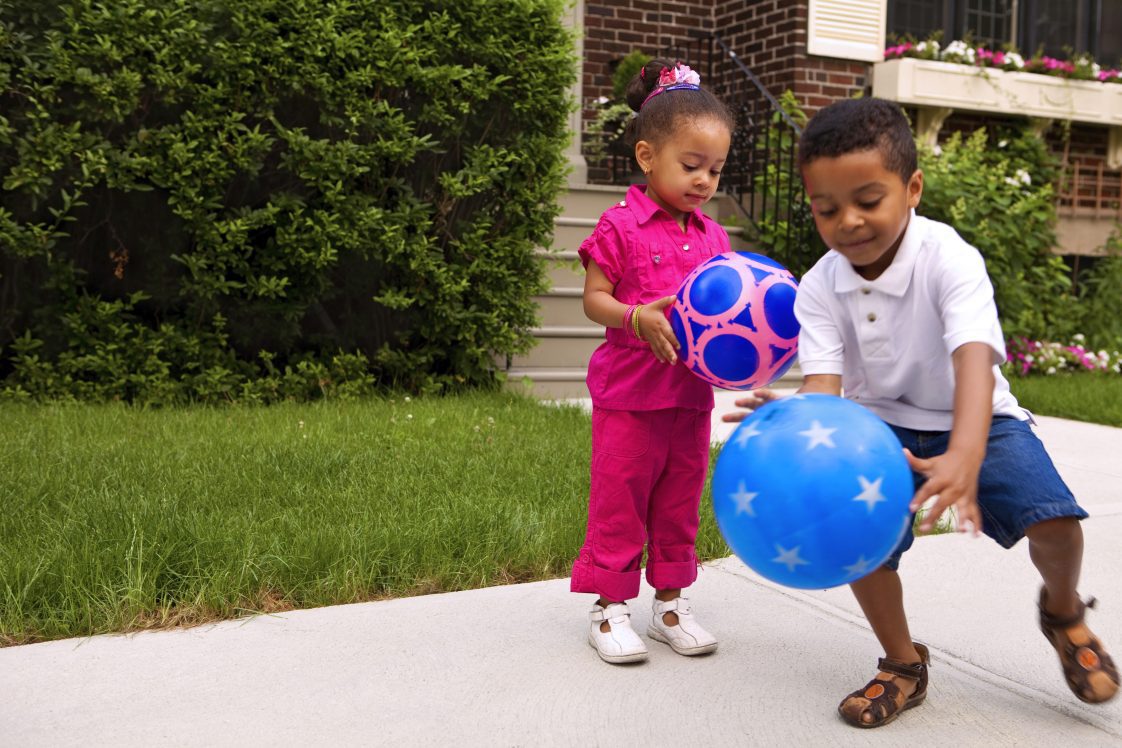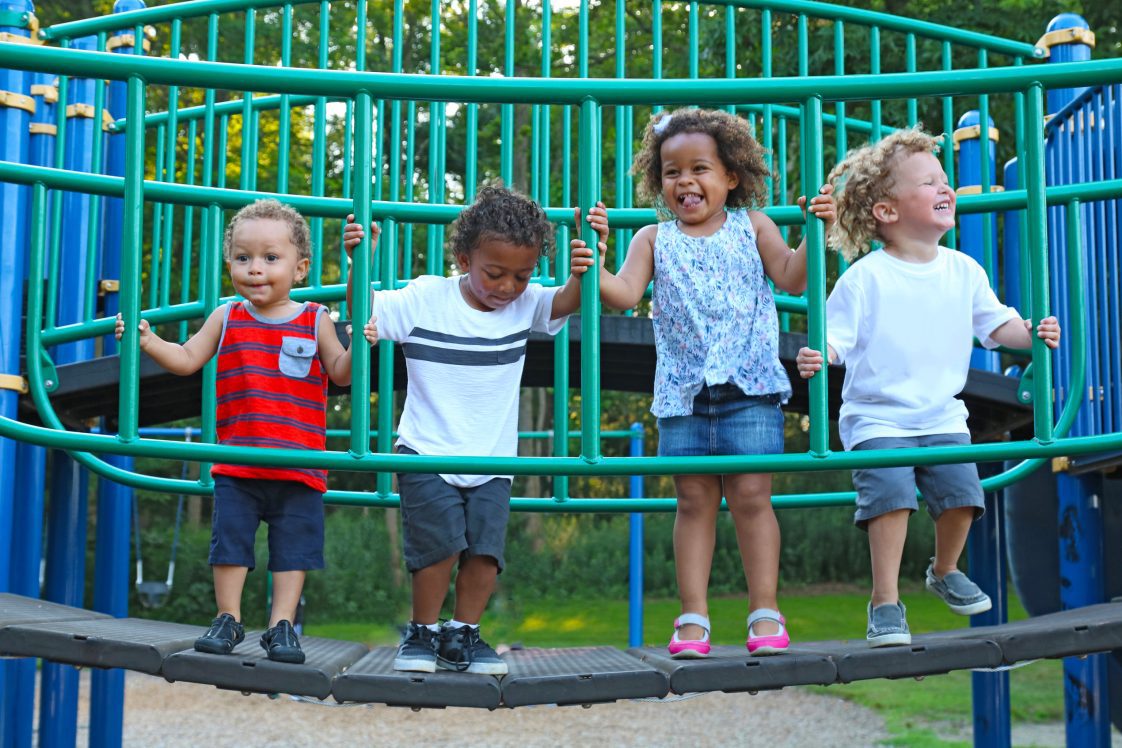Home & Family

This overview is the first in a three-part series on supporting outdoor play and physical movement.
Free outdoor play gives children the chance to get comfortable with movement and nature. Free play has surprising learning benefits too. This overview helps parents and caregivers think about all the elements of play.
What Is Play?
 Children need physical, mental, and emotional-social activities in their everyday experiences. This is where play comes in. When you allow your child to play freely, you allow them to explore the world, discover things for themselves, and grow their curiosity. This helps them develop thinking and problem-solving skills and grow confidence. Children with limited mobility or different learning needs also benefit from free play, especially if the environment is adapted to give them progressive challenges they can achieve.
Children need physical, mental, and emotional-social activities in their everyday experiences. This is where play comes in. When you allow your child to play freely, you allow them to explore the world, discover things for themselves, and grow their curiosity. This helps them develop thinking and problem-solving skills and grow confidence. Children with limited mobility or different learning needs also benefit from free play, especially if the environment is adapted to give them progressive challenges they can achieve.
The outdoor environment is full of surprises—changing weather, changing seasons, and opportunities to experiment by moving bodies freely. Being outside is also an opportunity for unstructured play when children can run off some energy. Using all of the senses (touch, smell, sight, hearing and movement) outdoors helps support better mental wellness.
Play also has many social and emotional benefits. It engages children in social relationships such as sharing, thinking together, leading and following (taking turns), and planning together. These activities help children grow important social and emotional skills.
Main Ideas
- Outdoor play helps encourage physical growth.
- Play helps children grow socially and emotionally.
- Free play helps children gain confidence in their decisions.
Seven Cs of Play Spaces
One of the best things you can do for your child is to give them a space that encourages creative play. Susan Herrington at the University of British Columbia worked with 16 child care centers to explore how the design of outdoor play spaces at child care centers can encourage children’s play. As a landscape architecture researcher, she and her team discovered that better design reduces stress and improves social interaction. You can read more about the design characteristics in “Seven Cs: An Informational Guide to Young Children’s Outdoor Play Spaces,” but here are the seven basic elements.
 1. Character. The overall design of a play space can help children learn classification skills pre-math and language by talking with others while they play in the space, naming things, and putting ideas into action.
1. Character. The overall design of a play space can help children learn classification skills pre-math and language by talking with others while they play in the space, naming things, and putting ideas into action.
2. Context. The area around the play space can help create discussions about the bigger outside world.
3. Connectivity. Connections between different types of materials help children be aware of space. They can practice thinking skills as they experience these materials.
4. Change. Using different materials and space sizes allows children to choose how they interact with others. Choices help them explore their feelings and desires.
5. Chance. When things change over time—in a day or from season to season—children experience and understand themselves in context.
6. Clarity. A clear path or exit to and from a space allows children to choose where to go. This choice lowers their stress and enhances their play.
7. Challenge. Physical challenges allow children to experiment and learn from results. Sometimes this is called learning from risk-taking, which should be safe from harm.
Read More
Read more about the seven Cs of creative play spaces in Extension publication FCS-2751, “Let’s Play: The Seven Cs.” You will learn exciting ways that outdoor play spaces can support child development. Be sure to pay attention to the varied sensory environment. Are there interesting things to touch? Different textures? Natural and artificial items? Things that grow or change with seasons?
Ask Yourself:
How many of the Seven Cs are in this publication’s pictures?
Encouraging Through Story
You can encourage children to play by telling a story about the action. For example, if you say “Everybody is playing with their wagons,” you are gently encouraging them. “Do you want to join them?” When you name their play, you help them connect their emotions with actions, which helps them understand their own motivation. This is an inclusive practice, too, because you are encouraging children of all ages and abilities. Childhood is about learning. See Extension publication FCS-2750, “Let’s Play: Universal Design for Learning,” to find out more about adult roles.
The Benefits of Movement
Children learn by doing. When you allow your child to play outside, you support the development of their physical abilities by helping them have opportunities to control the movement of their bodies. Children practice their skills (both large muscle and small muscle) when they use them in everyday activities.
ENCOURAGING SAFE CHALLENGES
Children learn as they overcome small challenges. Observe your children and see what is new for them. Learning to walk on uneven ground might be a challenge, for example, or throwing and catching a ball. Overcoming safe and achievable challenges helps children learn about and develop confidence in their abilities.
BUILDING CONFIDENCE
When a child learns to make choices about their movements and can control their muscles, it helps raise their self-esteem.
If your child feels confident in their ability to perform physically, they feel more comfortable interacting with other children their age. If your child feels uncertain in their ability to function physically (like running, throwing, or kicking a ball), they may feel reluctant to play with their peers. Peer interactions are essential for social development.
Tips
1. Guide children by encouraging play. If they pick up rocks from a pond, ask if they are building a dam.
2. Engage outsiders. If a child is watching, ask them if they want to join the play.
3. Participate in play. If children seem stuck, ask how you can help them or what they may need to continue.
4. Most importantly, let them play.
Additional Resources
EXTENSION RESOURCES
- School Readiness Series on the Alabama Extension website at www.aces.edu:
- Parents Get Ready! FCS-2557
- Children Get Ready! FCS-2558
- Overview, FCS-2556
- Good BEE-ginnings (Begin Education Early, No. 1–9)
- Important topics for supporting preschoolers
- Parenting newsletters: Just in Time Parenting series (www.jitp.info) that provides developmentally appropriate tips for parenting young children from prenatal to age 5.
- Todos los materiales están también en español www.jitp.info/es. (These materials are also available in Spanish.)
FOR EDUCATORS
- Learn more about creating inclusive play spaces for all children from the Division for Early Childhood of the Council for Exceptional Children: Environment: Promoting Meaningful Access, Participation and Inclusion
- Read more about the “Seven Cs”
- Herrington S, Lesmeister C, Nicholls J, and Stefiuk, K. 2007. An informational guide to young children’s outdoor play spaces, Seven Cs. Consortium for Health, Intervention, Learning and Development (CHILD). https://sala.ubc.ca/sites/sala.ubc. ca/files/documents/7Cs.pdf
 Silvia L. Vilches, Extension Specialist, Assistant Professor, Family and Child Development, Auburn University
Silvia L. Vilches, Extension Specialist, Assistant Professor, Family and Child Development, Auburn University
New February 2024, Let’s Play: Child Care Outdoor Play Design, FCS-2749
This publication was supported by an Auburn University Research Grant for the SaPHIRE project (Starting Physical Health Intervention Really Early).
The Seven Cs guidelines for outdoor play spaces was developed by Susan Herrington and her students at the University of British Columbia, Canada. https://sala.ubc.ca/sites/sala.ubc.ca/files/documents/7Cs.pdf. The research aims to help people design outdoor play spaces that support the development of young children and to integrate the unique qualities of playing outdoors. Here, we have adapted the Seven Cs for Alabama child care providers.




